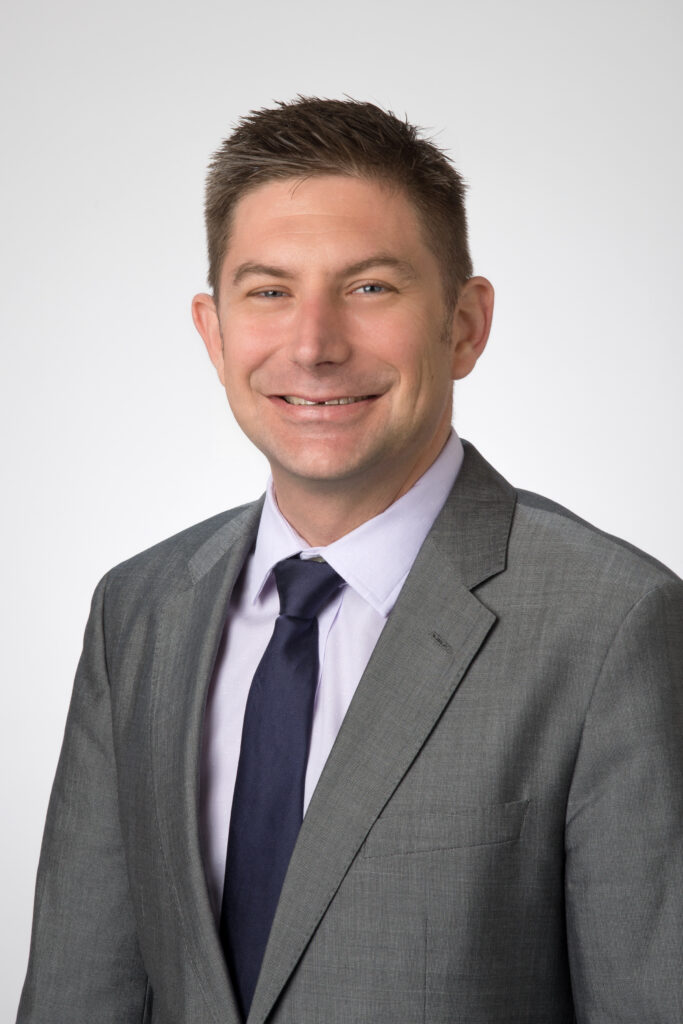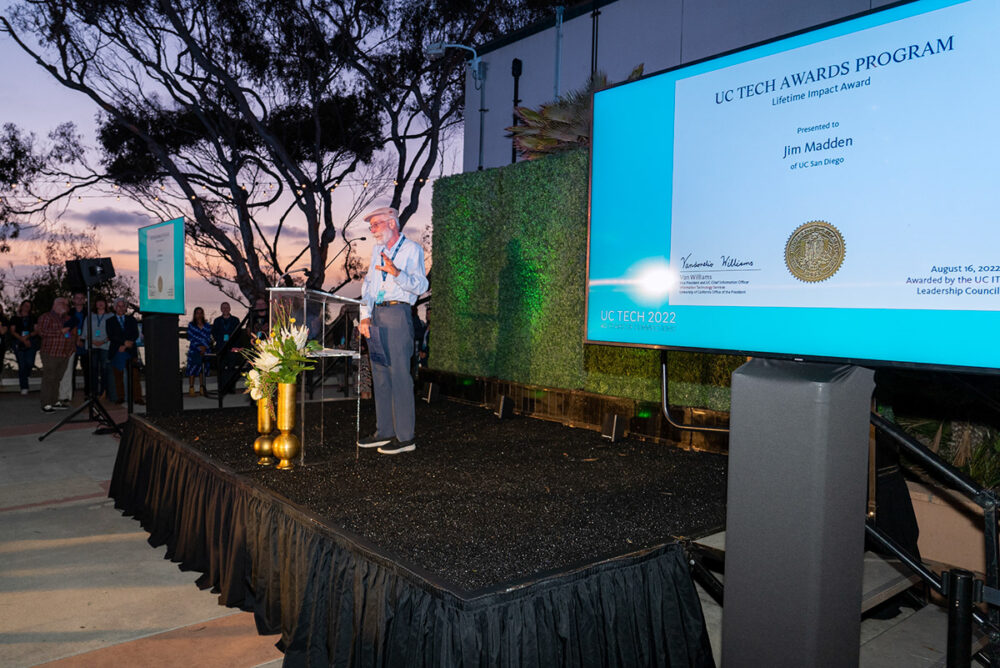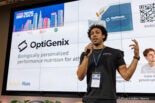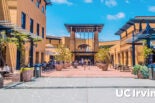By Mark Hersberger. In September 1972, Jim Madden moved his wife and three-month-old baby halfway across the country to take a new position at UC San Diego. He admits being too naive to have had any long-term plan for how long he would stay or what he would contribute. Some 50 years and dozens of accomplishments later, Madden is the inaugural recipient of the UC Tech Lifetime Impact Award, which recognizes an individual who has contributed significant expertise, passion and commitment to technology in the UC system. Madden was honored for his exceptional impact on the university, benefitting not only UC, but education and research networking across California.
It Began on a Burroughs B6700
Madden got his start in computers at the University of Illinois back in the late 1960s. After earning a math degree, he was working on a master’s degree in electrical engineering and also working part time at the university developing weather forecasting models. To do this, he used a partially-designed but not-yet-built primitive supercomputer. Called Illiac IV, the supercomputer was meant to increase computing speed by working within a system of machines, including one known as a Burroughs Corp. B6700.
“There was no actual computer science department at the time, so it was a little strange,” recalled Madden. “As time went on, I got much more interested in how the B6700 worked and a lot less interested in doing any kind of mathematics and really kind of caught a computing disease. I couldn’t stay away.”
Several of the software development people from the University of Illinois, including Madden, traveled out to San Diego numerous times to work on a B6700 that had recently been installed in the UC San Diego Computer Center. During those visits, they talked in depth with the management and technical staff about how they ran their facility.
A component of his work for University of Illinois involved connecting the Illiac IV/B6700 to the Advanced Research Projects Agency Network (ARPANET)—a precursor to the Internet, intended to link computers at federally funded research institutions over telephone lines. One of Madden’s responsibilities was to build the networking software, and since UC San Diego was also trying to get its own B6700 connected to ARPANET, he made another visit to San Diego to confer.
Eventually, the staff member managing the UC San Diego B6700 computer left. “They offered me the job to replace him and I came here in fall of 1972,” Madden said. “I took his job and I took his house. My wife came not having seen the place.” (Incidentally, he lived in the house for 30 years and still owns it.)
Madden worked at the university’s central computer center, then headed by computer science pioneer Ken Bowles. They got the B6700 connected to ARPANET in 1973, and his job was to maintain the system software, including the ARPA connection.
As the years passed, Madden contributed to Bowles’ famous UCSD Pascal system, generating B6700 code so that students who had learned programming using the system could continue to use that language on the central machines.
As his career progressed, he spearheaded innovations that have evolved and endured to this day. Key milestones include:
- 1984-1986: Designed and installed the first campus local area network (LAN)
- 1988-1989: Connected UC San Diego and its students to the Internet
- Early 1990s: Worked with Brian Kantor to design and implement a campuswide email system
- 1995: Connected dorm rooms on campus to the Internet
- Early 2000s: Worked with Brian Kantor and Sean Cross to design and write a homegrown system for domain name/IP address management
Madden’s fingerprints and legacy touch all parts of our present-day campus network. He also worked with networking people from other campuses to connect universities, labs and K-12 systems statewide through foundational work with California Research & Education Network (CalREN) and Corporation for Education Network Initiatives in California (CENIC). CalREN has grown into a high-capacity computer network consisting of some 8,000 miles of optical fiber and serving over 20 million users to connect educators, researchers and individuals. Upon CENIC’s 20th anniversary in 2017, Madden was among 18 people recognized with its Founders Circle Award.
Memories and Mentorship
Valerie Polichar is UC San Diego’s Senior Director of Academic Technology Services. Back in 1982, she was a 17-year-old first-year student at UC San Diego. She signed up for a computer account and started messaging people, eventually finding Madden. He helped her with programming lessons, provided timely pep talks during grad school and eventually hired her full time. Polichar reported to him for 22 years.
Around 1990, David Hutches, a UC San Diego Enterprise Architect, took a more circuitous path to finding Madden. He was a UC San Diego grad student studying computer science who kept hearing Madden’s name come up. “His name permeated every technical conversation,” Hutches recalled. “It didn’t matter if it was about the network, or systems or anything. I hadn’t met him, but his reputation preceded him as one of the icons in the technical community.” When they finally met up, Hutches was impressed with how welcome Madden made him feel.
Both Polichar and Hutches remarked on his thoughtfulness, inquisitive nature and desire to help. “When you go to meet him, you always have to expect questions,” Polichar explained. “He’s going to want data to help solve the problem. No matter how prepared you are, he will ask a question you don’t have the answer to.”
Hutches said, “When you ask him a question, he won’t immediately blurt out an answer. You can see the gears turning and the cogitation happening. He wants to provide a thoughtful, well-reasoned answer. Sometimes he might just say ‘hmm’ and start twisting the end of his mustache.”
On the fun side, Polichar remembered listening to music together and going off for late-afternoon, sugar-infused snacks. Hutches recalled Jim’s copious coffee consumption, with the used cups piling into an ever-growing tower on his desk.
Finally, Polichar cited a key trait of his that she tries to emulate: his dedication to problem solving. “He’s extremely tenacious with a problem and won’t let go of it until it’s solved,” she explained. “He works through methodically until he finds the solution. And he’s modeled that behavior—I think everyone who has worked with and for him tries to catch a little of that tenacity and willingness to try one more thing.”
Enabling Education
Stefan Savage, a UC San Diego computer science professor, met Madden in 2000. They connected as a result of Savage’s students conducting data measurements and other experiments on the UC San Diego network. “He was super nice about it,” remembered Savage, “especially considering I was creating a bunch of pain for him!”
From there a collaboration blossomed that helped Savage and his students overcome a typical class-vs-real world conundrum. “Jim was the one who explained to us how the campus network actually functioned, which was always so much more complex than our mental model and what we were able to teach in class,” said Savage, who is the Irwin Mark and Joan Klein Jacobs Professor in Information and Computer Science at UC San Diego. “He also arranged special dispensation for us so we could continue doing measurements and research on the network.” Over the years, that network access facilitated research into large-scale denial-of-service attacks, Internet worm outbreaks and other aspects of cybercrime.
Madden’s willingness to help students and researchers does not surprise Hutches. “He has a deep and abiding appreciation for higher education,” he explained. “He’s not an educator in the conventional sense. He’s not teaching classes, but he embodies the best of what an educator does. He doesn’t tell you what to think, he demonstrates how to think. You learn the process of thinking from him. And that is the essence of being an effective educator.”
Savage described Madden’s knowledge of the network as “encyclopedic,” saying, “He’s extremely good at explaining the network, including the add-ons and optimizations that make it complex, and why certain configurations are in place. We’ve definitely been educated by him on a frequent basis.”
Lasting Legacy
Those who know Madden best remark not just on the importance of his work at UC San Diego, but how he’s kept himself on the cutting edge of technology.
Madden admitted he never cured himself of the “computing disease” that took hold back in the 60s. “I spend 12 hours a day in front of a laptop watching both what’s happening on campus and looking at ideas other people have—and I’ve done that all my life,” he explained. “When an interesting idea comes along, I dig into it and really try to understand it. I’m fortunate enough to be able to do that at UC San Diego.”
Savage said, “Without the network, nothing works. I think we’re all grateful for how he has kept it performing at a high level.”
For Polichar and her colleagues, it was an easy decision to nominate Madden for the Lifetime Impact Award—part of the newly-expanded UC Tech Awards, which celebrate the achievements of UC individuals or teams in designing, implementing, operating or supporting high-impact technology initiatives. Recipients are selected by a panel of UC chief information officers (CIOs).
Polichar said, “When we looked back at his impact, we saw he was influential from day one. He helped change the face of first computing, then networking, the whole way through at UC San Diego. There really have been only a small number of people in the UC system that could even come close to that, and we couldn’t imagine anyone that had reached the level that he has.”
Added Hutches, “Jim is a presence. I think it’s hard to overstate the kind of impact he’s had on this campus and within the UC community. I can’t think of anybody that I know who would be more deserving.”
Polichar admitted to shedding a few tears when learning he would be honored. “We were all thrilled,” she said. “There’s nobody more deserving. Jim has been able to gain the trust of colleagues thanks to his expertise and willingness to collaborate, and is highly regarded for having made a significant difference in the lives of colleagues across the UC system.”
When asked to describe his reaction to receiving the Lifetime Impact Award, Madden, ever the modest Midwesterner, laughed and said, “Well, I’m a little embarrassed about that! I think there are 20-30 people who’ve done at least as much as I have. Maybe they all had the good sense to move on. I guess I’m just the one who never retired and moved to a ranch.”
On working for 50 straight years at UC San Diego, he reflected, “Of course San Diego is a nice place to live, but the people I’ve been able to work with—faculty, staff, students—have kept the place interesting, and there have always been interesting problems to solve. And I think I’ve done some good work in that way.”
Media Contact: Leslie Sepuka – lsepuka@ucsd.edu
About the author:

Mark Hersberger
Communications and Outreach Manager
Information Technology Services
UC San Diego







